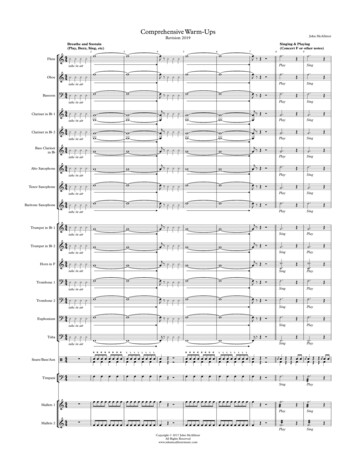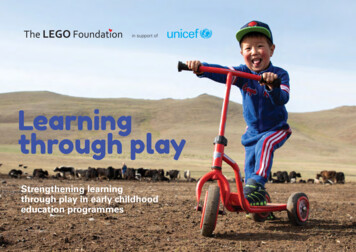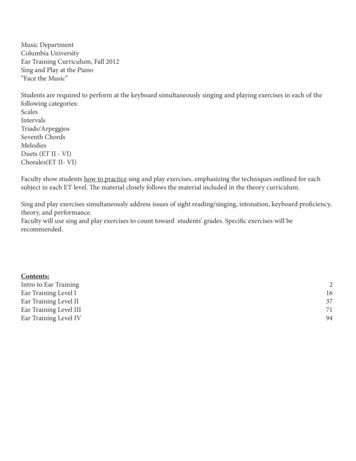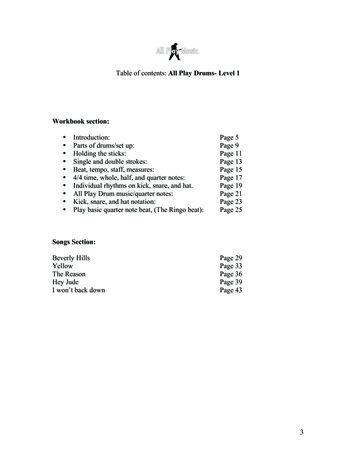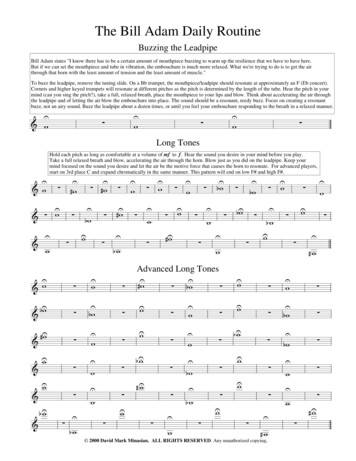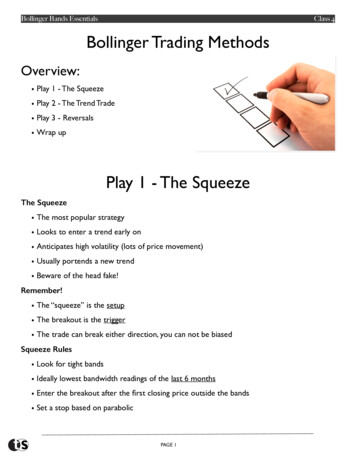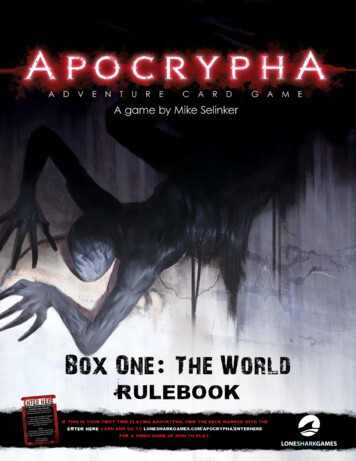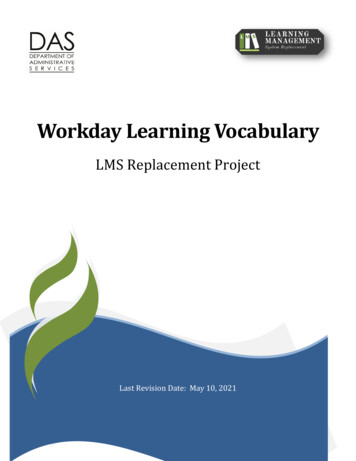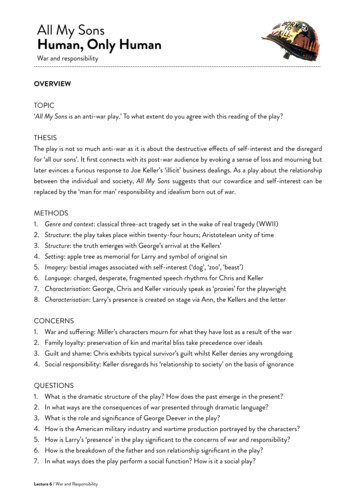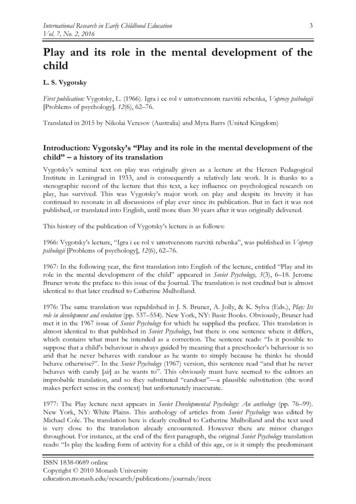
Transcription
International Research in Early Childhood EducationVol. 7, No. 2, 20163Play and its role in the mental development of thechildL. S. VygotskyFirst publication: Vygotsky, L. (1966). Igra i ee rol v umstvennom razvitii rebenka, Voprosy psihologii[Problems of psychology], 12(6), 62–76.Translated in 2015 by Nikolai Veresov (Australia) and Myra Barrs (United Kingdom)Introduction: Vygotsky’s “Play and its role in the mental development of thechild” – a history of its translationVygotsky’s seminal text on play was originally given as a lecture at the Herzen PedagogicalInstitute in Leningrad in 1933, and is consequently a relatively late work. It is thanks to astenographic record of the lecture that this text, a key influence on psychological research onplay, has survived. This was Vygotsky’s major work on play and despite its brevity it hascontinued to resonate in all discussions of play ever since its publication. But in fact it was notpublished, or translated into English, until more than 30 years after it was originally delivered.This history of the publication of Vygotsky’s lecture is as follows:1966: Vygotsky’s lecture, “Igra i ee rol v umstvennom razvitii rebenka”, was published in Voprosypsihologii [Problems of psychology], 12(6), 62–76.1967: In the following year, the first translation into English of the lecture, entitled “Play and itsrole in the mental development of the child” appeared in Soviet Psychology, 5(3), 6–18. JeromeBruner wrote the preface to this issue of the Journal. The translation is not credited but is almostidentical to that later credited to Catherine Mulholland.1976: The same translation was republished in J. S. Bruner, A. Jolly, & K. Sylva (Eds.), Play: Itsrole in development and evolution (pp. 537–554). New York, NY: Basic Books. Obviously, Bruner hadmet it in the 1967 issue of Soviet Psychology for which he supplied the preface. This translation isalmost identical to that published in Soviet Psychology, but there is one sentence where it differs,which contains what must be intended as a correction. The sentence reads: “Is it possible tosuppose that a child’s behaviour is always guided by meaning that a preschooler’s behaviour is soarid that he never behaves with candour as he wants to simply because he thinks he shouldbehave otherwise?”. In the Soviet Psychology (1967) version, this sentence read “and that he neverbehaves with candy [sic] as he wants to”. This obviously must have seemed to the editors animprobable translation, and so they substituted “candour”—a plausible substitution (the wordmakes perfect sense in the context) but unfortunately inaccurate.1977: The Play lecture next appears in Soviet Developmental Psychology: An anthology (pp. 76–99).New York, NY: White Plains. This anthology of articles from Soviet Psychology was edited byMichael Cole. The translation here is clearly credited to Catherine Mulholland and the text usedis very close to the translation already encountered. However there are minor changesthroughout. For instance, at the end of the first paragraph, the original Soviet Psychology translationreads: “Is play the leading form of activity for a child of this age, or is it simply the predominantISSN 1838-0689 onlineCopyright 2010 Monash ns/journals/irece
International Research in Early Childhood EducationVol. 7, No. 2, 20164form?”. The end of this sentence in the 1977 translation reads: “or is it simply the mostfrequently encountered form?”. Most of the changes in this 1977 translation are minor (e.g.,“which are highly important” is replaced by “that are very important”; “he will go away” isreplaced by “he will turn away”). It should be noted that, although previous translations aregenerally attributed to Catherine Mulholland, this is the first time that she is named as thetranslator.1977: This translation also appeared in 1977 on the Marxists Internet Archive. (Thetranslation—probably unchanged, though this is now impossible to check—now appears on theMarxists.org website dated 2002 (see below) with its source given as Voprosy psihologii [Problemsof psychology], 1966): htm1978: A version of the Play lecture—“The Role of Play in Development”—appeared in Mind inSociety: The Development of Higher Psychological Processes (pp. 92–105). Cambridge, MA: HarvardUniversity Press.It has frequently been noted that this text is hardly a translation at all. Van der Veer and Valsiner,in their Introduction to The Vygotsky Reader (1994), refer to this book as “the cocktail-type mixingof various of (Vygotsky’s) ideas to fit the American audience” (p. 4).In the Editors’ Preface to Mind in Society (1978), Cole and his fellow editors, Vera John-Steiner,Sylvia Scribner, and Ekkeb Souberman, give the source of the Play lecture as Voprosy psihologii[Problems of psychology] 1966. In a famous apologia they also make clear the “significantliberties” they have taken with Vygotsky’s texts in this issue:The reader will encounter here not a literal translation of Vygotsky but rather our editedtranslation of Vygotsky, from which we have omitted material that seemed redundantand to which we have added material that seemed to make his points clearer . . . . Werealize that in tampering with the original we may have distorted history (p. x).Michael Cole’s Prologue to Rieber and Robinson’s The Essential Vygotsky (2004) makes clearerwhy these drastic editorial changes were considered necessary at the time:I received the Vygotsky manuscripts from Luria in the early 1970s. But even with theexpert help of able colleagues and a good translation to work from, I could not convincethe publisher with whom Luria had entered into an agreement about the publication ofVygotsky’s work that the manuscripts were worth publishing. All of the problems that Ihad experienced earlier remained in place. The work seemed dated, the polemics eitheropaque or outdated, and the overall product certain to produce fiscal disaster, not to saypersonal embarrassment.Faced with this seemingly unsurmountable barrier, and with help from Luria,whom I visited every year or two and corresponded with regularly, we created a selectionof readings from the two manuscripts he had given me to which we added several essaysthat seemed of an applied nature so that it would be possible for readers to see how theabstract theoretical arguments played out in practice. The result, which was titled Mind inSociety, was published in 1978. I heaved a great sigh of relief. (p. xi)The “selection of readings” which is Mind in Society has become the most widely read Vygotskytext in the world. It unquestionably established Vygotsky in the West as a major psychologist,and began the “Vygotsky boom” as Cole terms it later in the Prologue. But it also substituted aISSN 1838-0689 onlineCopyright 2010 Monash ns/journals/irece
International Research in Early Childhood EducationVol. 7, No. 2, 20165streamlined version of Vygotsky for the real texts, and it continues to be the case even today thatit is Mind in Society that appears on university reading lists, rather than, say, The Vygotsky Reader(now available on the Marxists Internet Archive).The version of the Play lecture found in Mind in Society is considerably shorter than the fullMulholland translation that we have so far been concerned with. It is approximately 3000 wordsshorter than the Mulholland text (which is 8400 words long) and is different from theMulholland text (and the stenographic record that is based on). It is also to a considerable extentrephrased; the editors allowed themselves considerable latitude in their rewording of what theyregarded as Vygotsky’s “opaque” or “outdated” original texts. However, a full comparison ofthis version with the Mulholland translation is not possible here.2002: A differently dated version of the original Mulholland translation appeared on the MarxistsInternet Archive .htm)This is essentially the same Mulholland translation that we have encountered in SovietDevelopmental Psychology (1977) and in other contexts.2002: Play and its Role in The Mental Development of The Child [Kindle Edition] (CatherineMulholland, Trans.). This is the same translation as that published in the same year on theMarxists Internet Archive. However the source of the text is given here as the website AllAbout-Psychology.comIt is therefore clear that the Mulholland translation of the Play lecture has been—with thenotable exception of the text in Mind in Society—the only translation available in print and onlinefor nearly 50 years. This fact is testimony to the strengths of this translation which is, in general,faithful both to the original stenographic record, and to the complexities of Vygotsky’s thoughtin this dense and often demanding text.In our translation we used both Mulholland translations (1967 and 1977) as a combination “basetext” and focused particularly on those places in that text which did not offer a perfectlyadequate rendering of the Russian original. Our aim has been to provide an authentic translationthat should, above all, be faithful to the original stenographic record—Vygotsky’s words—withall its repetitions and sometimes hurried arguments (to be expected in what was after all a spokentext). This has involved us in some long discussions about particular sticking points, whereparticular Vygotskyan ideas seemed not to be fully conveyed by either Mulholland translation, orwhere the Mulholland translation was hard to follow.The work of this translation has been carried out as an email conversation, which has taken placeover more than 18 months, between Nikolai Veresov, initially in Finland and subsequently inMonash University, Australia, and Myra Barrs in London.ISSN 1838-0689 onlineCopyright 2010 Monash ns/journals/irece
International Research in Early Childhood EducationVol. 7, No. 2, 20166Vygotsky’s “Play and its role in the mental development of the child”In speaking of play and its role in the preschooler’s1 development, we are concerned with twofundamental questions: first, how play itself arises in development – its origin and genesis;second, the role that this activity, play, has in development, and its meaning as an aspect ofdevelopment in a child of preschool age. Is play the leading form of activity, or is it simply thepredominant activity, in a child of this age?It seems to me that from the point of view of development, play is not the predominant form ofactivity, but is, in a certain sense, the leading line of development in the preschool years.Let us now consider the problem of play itself. We know that a definition of play based on thepleasure it gives the child is not correct for two reasons – first, because there are a number ofactivities that give the child much keener experiences of pleasure than play does.For example, the pleasure principle applies equally well to the sucking process, in that the childderives functional pleasure from sucking a pacifier even when he is not being satiated.On the other hand, we know of games in which the activity itself does not afford pleasure –games that predominate at the end of the preschool and the beginning of school age and thatgive pleasure only if the child finds the result interesting. These include, for example, sportinggames (not just athletic sports but also games with an outcome, games with results). They arevery often accompanied by a keen sense of displeasure when the outcome is unfavourable to thechild.Thus, defining play on the basis of pleasure can certainly not be regarded as correct.Nonetheless, it seems to me that to refuse to approach the problem of play from the standpointof fulfilment of the child’s needs, his incentives to act, and his affective aspirations would resultin a terrible intellectualization of play. The trouble with a number of theories of play lies in theirintellectualization of the problem.I am inclined to give an even more general meaning to the problem; and I think that the mistakeof many age-based theories is their disregard of the child’s needs – taken in the broadest sense,from inclinations to interests, as needs of an intellectual nature – or, more briefly, their disregardof everything that can come under the name of incentives and motives for activity. We oftendescribe a child’s development as the development of his intellectual functions, i.e., every childstands before us as a theoretical being who, according to the higher or lower level of hisintellectual development moves from one stage to another.Without a consideration of the child’s needs, inclinations, incentives, and motives to act – asresearch has demonstrated – there will never be any advance from one stage to the next. I thinkthat an analysis of play should start with an examination of these particular aspects.This paper of Vygotsky is devoted to the development of play in early childhood. In the original Russian textVygotsky uses the word doshkol’nik (дошкольник)/preschooler which according to Russian educational systemrefers to the age from 3 to 6 years. The Russian terms “preschool” and “kindergarten” refer to the same age periodand therefore is different from the English/Australian usage which refers only to the last year before school. In thetext “preschool age” and “preschool child” means a child at the age from 3 to 6 years, “very young child” is frombirth to 3 years.1ISSN 1838-0689 onlineCopyright 2010 Monash ns/journals/irece
International Research in Early Childhood EducationVol. 7, No. 2, 20167It seems to me that every advance from one age-related level to another is connected with anabrupt change in motives and incentives to act.What is of the greatest value to the infant has almost ceased to interest the toddler. Thismaturing of new needs and new motives for activity should be moved to the first plane.Especially as it is impossible to ignore the fact that a child satisfies certain needs and incentivesin play; and without understanding the special nature of these incentives, we cannot imagine theunique type of activity that we call play.At preschool age special needs and incentives arise which are very important for the whole ofthe child’s development and which directly lead to play. In essence, there arise in a child of thisage a large number of unrealizable tendencies and immediately unrealizable desires. A very youngchild tends to resolve and gratify his desires at once. Any delay in fulfilling them is difficult forthe early years child and is acceptable only within certain narrow limits; no one has met a childunder three who wanted to do something a few days hence. Ordinarily, the interval between themotive and its realization is extremely short. I think that if there were no maturing in preschoolyears of needs that cannot be realized immediately, there would be no play. Experiments showthat the development of play is arrested both in intellectually underdeveloped children and inthose who are emotionally immature.From the viewpoint of the affective sphere, it seems to me that play is invented at the point indevelopment where unrealisable tendencies begin to appear. This is the way a very young childbehaves: he wants a thing and must have it at once. If he cannot have it, either he throws atemper tantrum, lies on the floor and kicks his legs, or he is refused, pacified, and does not get it.His unsatisfied desires have their own particular modes of substitution, rejection, etc. Towardthe beginning of the preschool age, unsatisfied desires and tendencies that cannot be realizedimmediately make their appearance, while on the other hand the tendency to immediatefulfilment of desires, characteristic of the preceding stage, is retained. For example, the childwants to be in his mother’s place, or wants to be a rider on a horse. This desire cannot befulfilled right now. What does the very young child do if he sees a passing cab and wants to ridein it, no matter what may happen? If he is a spoiled and capricious child, he will demand that hismother put him in the cab at any cost, or he may throw himself on the ground right there in thestreet, etc. If he is an obedient child, used to renouncing his desires, he will turn away, or hismother will offer him some candy, or simply distract him with some stronger affect, and he willrenounce his immediate desire.In contrast to this, a child over three clearly shows his own particular conflicting tendencies. Onthe one hand, a large number of long-lasting needs and desires appear that cannot be met at oncebut that nevertheless are not passed over like whims; on the other hand the urge towards theimmediate realization of desires is almost completely retained.Henceforth play appears which – in answer to the question of why the child plays – must alwaysbe understood as the imaginary, illusory realization of unrealizable desires.Imagination is a new formation that is not present in the consciousness of the very young child,is totally absent in animals, and represents a specifically human form of conscious activity. Likeall functions of consciousness, it originally arises from action. The old adage that children’s playis imagination in action can be reversed: we can say that imagination in adolescents andschoolchildren is play without action.ISSN 1838-0689 onlineCopyright 2010 Monash ns/journals/irece
International Research in Early Childhood EducationVol. 7, No. 2, 20168It is difficult to imagine that the incentive compelling a child to play is really just the same kindof affective incentive as sucking a pacifier is for an infant.It is also hard to accept that the pleasure derived from preschool play is conditioned by the sameaffective mechanism as the simple sucking of a pacifier. This simply does not fit our notions ofpreschool development.All of this is not to say that play occurs as the result of each and every unsatisfied desire: a childwants to ride in a cab, the wish is not immediately gratified, so the child goes into his room andbegins to play cabs. It never happens just this way. Here we are concerned with the fact that thechild not only has individual, affective reactions to separate phenomena but also generalizedunspecified affective tendencies. Let us take the example of a microencephalic child sufferingfrom an acute inferiority complex: he is unable to participate in children’s groups; he has been soteased that he smashes every mirror and pane of glass showing his reflection. But when he wasvery young, it had been very different; then, every time he was teased there was a separateaffective reaction for each separate occasion, which had not yet become generalized. Atpreschool age the child generalizes his affective relation to the phenomenon regardless of theactual concrete situation, because the affective relation is connected with the meaning2 of thephenomenon, in that it continually reveals his inferiority complex.Play is essentially wish fulfilment – not, however, isolated wishes, but generalized affects. A childat this age is conscious of his relationships with adults, and reacts to them affectively; but incontrast to early childhood,3 he now generalizes these affective reactions (he respects adultauthority in general, etc.).The presence of such generalized affects in play does not mean that the child himselfunderstands the motives that give rise to a game or that he plays consciously. He plays withoutrealizing the motives of the play activity. In this, play differs substantially from work and othertypes of activity. On the whole it can be said that the sphere of motives, actions and incentives isless open to awareness at this stage, and becomes accessible to consciousness only at thetransitional age. Only an adolescent can clearly determine for himself why he does this or that.We shall leave the problem of the affective aspect for the moment – considering it as given –and shall now examine how the play activity unfolds.I think that in finding criteria for distinguishing a child’s play activity from his other generalforms of activity it must be accepted that, in play, a child creates an imaginary situation. Thisbecomes possible on the basis of the separation that occurs, in the preschool period, of thevisual and meaning fields.4This is not a new idea, in the sense that imaginary situations in play have always been recognized;but they have always been regarded as one of the groups of play activities. Thus the imaginarysituation has always been classified as a secondary feature of play activity. In the view of earlierwriters the imaginary situation did not share those criterial attributes which are the definingcharacteristics of play in general, but only the attributes of a particular group of play activities.Vygotsky uses the term smysl (смысл) here.Early childhood is the period from birth to 3 years.4 Vidimoe i smyslovoe pole (visual and sense fields) in the Russian original23ISSN 1838-0689 onlineCopyright 2010 Monash ns/journals/irece
International Research in Early Childhood EducationVol. 7, No. 2, 20169I find three main flaws in this argument. First, there is the danger of an intellectualistic approachto play. If play is to be understood as symbolic, there is the danger that it might turn into a kindof activity akin to algebra in action; it would be transformed into a system of signs generalizingactual reality. Here we find nothing specific in play, and look upon the child as an unsuccessfulalgebraist who cannot yet write the symbols on paper, but depicts them in action. It is essentialto show the connection with incentives in play, since play itself, in my view, is never symbolicaction in the proper sense of the term.Second, I think that this idea presents play as a cognitive process. It stresses the importance ofthe cognitive process while neglecting not only the affective aspect but also the fact that play isthe child’s activity.Third, it is vital to discover exactly what this activity does for development, i.e., what mightdevelop in the child with the help of the imaginary situation.Let us begin with the second question, as I have already briefly touched on the problem of theconnection with affective incentives. We observed that in the affective incentives leading to playthere are the beginnings not of symbolism, but of the necessity for an imaginary situation. If playis really developed from unsatisfied desires, if ultimately it is the realization in play form oftendencies that cannot be realized at the moment, then elements of imaginary situations willinvoluntarily be included in the affective nature of play itself.Let us take the second instance first – the child’s activity in play. What does a child’s behaviourin an imaginary situation mean? We know that there is a form of play, distinguished long ago andrelating to the late preschool period, but considered to develop mainly at school age, namelygames with rules. A number of investigators, although not at all belonging to the camp ofdialectical materialists, have approached this area along the lines recommended by Marx when hesaid that “the anatomy of man is the key to the anatomy of the ape.” They have begun theirexamination of play in the early years in the light of later rule-based play and have concludedfrom this that play involving an imaginary situation is, in fact, rule-based play. It seems to methat one can go even further and propose that there is no such thing as play without rules andthe child’s particular attitude toward them.Let us expand on this idea. Take any kind of play that involves an imaginary situation. Theimaginary situation already contains rules of behaviour, although this is not a game withformulated rules laid down in advance. The child imagines herself to be the mother and the dolla child, so she must obey the rules of maternal behaviour. This was very well demonstrated by aresearcher in an ingenious experiment based on Sully’s famous observations. The latter describedas remarkable play in which the play situation coincides with reality. One day two sisters, agedfive and seven, said to each other: “Let’s play sisters.” Here Sully was describing a case in whichtwo sisters were playing at being sisters, i.e., playing at reality. The above-mentioned experimentbased its method on children’s play, suggested by the experimenter, that dealt with realrelationships. In certain cases I have found it very easy to evoke such play in children. It is veryeasy, for example, to make a child play with its mother at being a child while the mother is themother, i.e., play at what is, in fact, true. The vital difference in play, as Sully describes it, is thatthe child, in playing, is trying to be a sister. In life the child behaves without thinking that she isher sister’s sister. She never behaves in relation to the other only as a sister would – exceptperhaps in those cases when her mother says, “Give in to her”. In the game of sisters playing at“sisters”, however, they are both concerned with displaying their sisterhood; the fact that twosisters begin to play at “sisters” makes them both acquire rules of behaviour. (I must always be aISSN 1838-0689 onlineCopyright 2010 Monash ns/journals/irece
International Research in Early Childhood EducationVol. 7, No. 2, 201610sister in relation to the other sister in the whole play situation.) Only actions that fit these rulesare acceptable to the play situation.In the game a situation is chosen that stresses the fact that these girls are sisters: they are dressedalike, they walk about holding hands – in short, they enact whatever emphasizes theirrelationship as sisters vis-a-vis adults and strangers. The elder, holding the younger by the hand,keeps telling her about other people: “That is theirs, not ours.” This means: “My sister and I actthe same, we are treated the same, but others are treated differently.” Here the emphasis is onthe sameness of everything that is concentrated in the child’s concept of a sister, and this meansthat my sister stands in a different relationship to me than other people. What passes unnoticedby the child in real life becomes a rule of behaviour in play.If play, then, were structured in such a way that there were no imaginary situation, what wouldremain? The rules would remain. The child would begin to behave in this situation as thesituation dictates.Let us leave this remarkable experiment for a moment and turn to play in general. I think thatwherever there is an imaginary situation in play, there are rules – not rules that are formulated inadvance and change during the course of the game, but rules stemming from the imaginarysituation. Therefore, to imagine that a child can behave in an imaginary situation without rules,i.e., as he behaves in a real situation, is simply impossible. If the child is playing the role of amother, then she has rules of maternal behaviour. The role the child fulfils, and her relationshipto the object, if the object has changed its meaning, will always stem from the rules, i.e., theimaginary situation will always contain rules. In play the child is free. But it is an illusoryfreedom.Although initially the investigator’s task was to disclose the hidden rules in all play with animaginary situation, we have received proof comparatively recently that the so-called pure gameswith rules (played by school children and older preschoolers) are essentially games withimaginary situations; for just as the imaginary situation has to contain rules of behaviour, soevery game with rules contains an imaginary situation. For example, what does it mean to playchess? To create an imaginary situation. Why? Because the knight, the king, the queen, and soforth, can move only in specified ways; because covering and taking pieces are purely chessconcepts; and so on. Although it does not directly substitute for real-life relationships,nevertheless we do have a kind of imaginary situation here. Take the simplest children’s gamewith rules. It immediately turns into an imaginary situation in the sense that as soon as the gameis regulated by certain rules, a number of possible actions are ruled out.Just as we were able to show at the beginning that every imaginary situation contains rules in aconcealed form, we have also succeeded in demonstrating the reverse – that every game withrules contains an imaginary situation in a concealed form. The development from an overtimaginary situation with covert rules to games with overt rules and a covert imaginary situationoutlines the evolution of children’s play from one pole to the other.All games with imaginary situations are simultaneously games with rules, and vice versa. I thinkthis thesis is clear.However, there is one misunderstanding that may arise, and must be cleared up from the start. Achild learns to behave according to certain rules from the first few months of life. For a veryyoung child such rules – for example, that he has to sit quietly at the table, not touch otherISSN 1838-0689 onlineCopyright 2010 Monash ns/journals/irece
International Research in Early Childhood EducationVol. 7, No. 2, 201611people’s things, obey his mother – are rules that make up his life. What is specific to the rules ofplay? It seems to me that several new publications can be of great aid in solving this problem. Inparticular, a new work by Piaget has been extremely helpful to me. This work is concerned withthe development of moral rules in the child. One part of this work is specially devoted to thestudy of rules of a game, in which, I think, Piaget resolve
child L. S. Vygotsky First publication: Vygotsky, L. (1966). Igra i ee rol v umstvennom razvitii rebenka, Voprosy psihologii [Problems of psychology], 12(6), 62–76. Translated in 2015 by Nikolai Veresov (Australia) and Myra Barrs (United Kingdom) Introduction: Vygot
